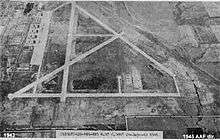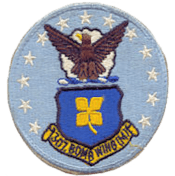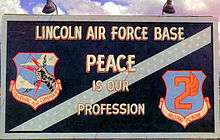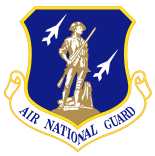Lincoln Air Force Base
| Lincoln Air Force Base | |
|---|---|
| Lincoln, Nebraska | |
|
Nebraska ANG KC-135R refueling F-15s | |
 Lincoln ANGB | |
| Coordinates | 40°51′04″N 096°45′33″W / 40.85111°N 96.75917°W |
| Type | Air Force Base |
| Site information | |
| Controlled by |
|
| Site history | |
| Built | 1943 |
| In use | 1943-Present |
| Garrison information | |
| Garrison |
 155th Air Refueling Wing 155th Air Refueling Wing |



Lincoln Air Force Base, was a United States Air Force installation located approximately 6 miles (9.7 km) northwest of Lincoln, Nebraska. The facility was a USAF base. It is located within the city limits of Lincoln.
A World War II Army Airfield, a Cold War naval air station, and later a United States Air Force installation under the Strategic Air Command (SAC), most of the original airfield and base is now owned by the City of Lincoln, Nebraska. It is used for general, commercial, and military aviation activities, as well as a colocated industrial park and public and private housing. Lincoln Airport, established in 1960, was built on the east side of the former Lincoln Air Force Base main runway. With the closure of Lincoln Air Force Base in 1966, the City of Lincoln assumed possession of those airfield facilities of the former military base not retained by the Nebraska Air National Guard or the Nebraska Army National Guard.
History
What would become Lincoln Airport began in the early 1920s when the city selected a plot of land Northwest of the city to be used as a municipal airport. Charles Lindbergh learned flying at Lincoln Airfield in 1922. Template:Lindbergh's flight log The airfield became an air mail stop in 1928 and became a United Air Lines stop during 1927, it continues its service to Lincoln to this day.
The Lincoln Airplane and Flying School was established in 1928 and operated at the airfield (which briefly was known as Lindbergh Field), before later moving to Union Airport a few miles east. In 1939, the Lincoln Airplane and Flying School was one of nine civilian contract flight schools contracted by the United States Army Air Corps for basic flight training of air cadets under the 4500 pilot training expansion program. The school was operated by E. J. Sias. However, due to the short summer flying season, flight training in Lincoln was closed on 15 November 1940. It was moved to Drane Field, Lakeland, Florida where it reopened with new owners under the name "Lakeland School of Aeronautics" and continued Army contract pilot training.[1] As part of the contract flying school, the Air Corps established the 47th Training Detachment to command the military flight cadets at the school, which apparently also moved to Lakeland along with the school.[2]
World War II
With war clouds forming in 1941, the United States Army Air Corps needed airfields for training flight and ground personnel. On 27 February 1942 Lincoln Airfield was announced to be home of an Army Airfield training field. Lincoln Army Airfield (AAF) was one of eleven USAAF training bases in Nebraska during World War II. Building construction was of wood, tar paper, and non-masonry siding. The use of concrete and steel was limited because of the critical need elsewhere. Most buildings were hot and dusty in the summer and very cold in the winter. Buildings consisted of hangars, barracks, warehouses, hospitals, dental clinics, dining halls, and maintenance shops. There were libraries, social clubs for officers, and enlisted men, and stores to buy living necessities. A large concrete aircraft parking ramp was poured along with four concrete runways. Their dimensions and directions were: 7000x150(N/S), 5500x150(NE/SW); 5500x150(E/W), and 7000x150(NW/SE).
The airfield was completed 151 days after the announcement with construction including barracks, paved streets, hangars and shops. 1,016 buildings and structures were constructed. Lincoln AAF was assigned to Western Technical Training Command with a mission to conduct flying training, basic military training and technical training. The plan consolidated a number of technical schools that were scattered throughout the country at that time. The first trainees arrived on 2 June 1942. Classrooms functioned 24 hours a day, seven days a week.
The 331st Army Air Force Base Unit commanded the support elements at Lincoln AAF as part of Air Technical Service Command, which was assigned to the 21st Bombardment Wing. It was also the home of the 12th Heavy Bombardment Processing Headquarters.
- The 616th Flying Training Group provided flying training instruction to aircrews of B-17 Flying Fortresses, Consolidated B-24 Liberators and Boeing B-29 Superfortresses.
- The 54th Training Sub-Depot provided indoctrination and basic training for 30,000 combat personnel; providing basic flight training for Army aviation cadets, and being a military separation center.
- The 604th Training Group provided instruction to over 25,000 aircraft mechanics, specializing in Fighter aircraft.
On 15 April 1944, the airfield was transferred to Second Air Force, initially providing B-25 Mitchell medium bomber replacement training (10th Bombardment Squadron). It also was a testing center for the new P-80 Shooting Star jet fighter (29th, 31st, 52d Fighter Squadrons) during April and May, with the squadrons moving to Muroc AAF California.
However, in the summer of 1944, Lincoln AAF became a Boeing B-29 Superfortress aircrew training and transition center. The 489th Bombardment Group arrived from Bradley Field, Connecticut on 17 December 1944 for training. The group stayed until April 1945 then transferred to Great Bend AAF Kansas. The group was alerted for movement overseas in the summer of 1945, but war with Japan ended before the group left the US. It was inactivated on 17 October 1945.
On 15 March 1945, Lincoln Field was reassigned from Second Air Force back to AAF Training Command and became a combat crew processing and distribution center until inactivated 15 December 1945 when Lincoln AAF was placed on inactive status. The airfield was transferred to the Army Corps of Engineers on 23 November 1946 for disposal.
Postwar years
In 1946 the facility was returned to its prewar civil use as an airport. Along with its civil use, Lincoln Airport became host to a flying unit of the newly formed Nebraska Air National Guard along with a Naval Reserve unit flying patrol aircraft. The 173rd Fighter Squadron became the host unit of what became known as Lincoln Air National Guard Base. Equipped with P-51 Mustang fighters in 1946, it was the second Air National Guard unit established. A few years later, F-80C Shooting Star jet fighters would replace the unit's F-51s until the advent of the Korean War.
Concurrently, the Naval Reserve established Naval Air Station Lincoln (NAS Lincoln) on the airport, primarily as home to Patrol Squadron 762 (VP-762) and its P-2 Neptune aircraft. [3]
Strategic Air Command





With the outbreak of the Korean War, the Lincoln Chamber of Commerce proposed the idea to Nebraska Senator Kenneth S. Wherry to reactivate Lincoln Airport as an active United States Air Force base. Senator Wherry fought for its activation and Lincoln Air Force Base was on a bill to be passed by the Congress until a few days before it was to be passed. Only an envoy of Lincoln residents and its mayor were between reactivation and failure. They lobbied only hours before the vote and were victorious. USAF Strategic Air Command officers would soon survey the land that would become Lincoln Air Force Base. On 21 February 1952 the provisional 4120th Air Base Group was activated at Lincoln AFB to begin work on the base. The unit was placed under the command of the Fifteenth Air Force.
On 1 February 1954 Lincoln AFB was officially activated and so was the 98th Air Base Group to assume control of the base and support units from the provisional 4120th ABG. On 16 April 1954, the 98th Air Refueling Squadron arrived at the new Lincoln AFB from Fairchild AFB, Washington with KC-97 Stratofreighters, being the first operational flying unit at the base.
On 25 July 1954, the B-29 Superfortress-equipped 98th Bombardment Wing was reassigned to Lincoln from Yokota AB, Japan. The 98th BMW had been assigned to Far East Air Force during the Korean War, where its 98th Bombardment Group had been engaged in combat operations since 1950. Its B-29s were somewhat war-weary after seeing combat in World War II and for the past four years over Korea, and the unit was brought to Lincoln to reorganize and re-equip.
Four months later, a second B-29 unit, the 307th Bombardment Wing arrived from Kadena AB, Okinawa, where its group had seen combat in the Korean War under Far East Air Force. The 98th and 307th brought a total of six combat bombardment squadrons to Lincoln, including one air refueling squadron.
To complete the complement of SAC units at Lincoln AFB, Fifteenth Air Force activated the 818th Air Division at the base on 11 October 1954. The 818th assumed control of the base support units from the 98th Air Base Group and was the intermediate command and control organization over the 98th and 307th Bombardment Wings. Its mission was to direct both wings in numerous tactical training exercises as directed by headquarters, Fifteenth Air Force and headquarters, Strategic Air Command.
On 15 October 1954, the 98th Bombardment Wing began receiving the new B-47E Stratojet, the replacement for its B-29s. The B-47 was the USAF's first swept-wing jet bomber, it was lightly armed however had a top speed of over 600 Miles Per Hour. It had a range of almost 5,000 miles and could fly at over 40,000 feet. Its mission was to penetrate the airspace of the Soviet Union and attack military targets. The 307th Bombardment Wing began receiving B-47Es in November and by the end of 1954, almost all B-29s had been sent to storage in Arizona.
With the arrival of the B-47s, Lincoln AFB, and the 818th Air Division was reassigned to SAC's Eighth Air Force on 1 January 1955. The 98th would become combat-ready with the new jet bomber in April 1955 and the 307th in June, with a total of 90 B-47s eventually being stationed at Lincoln. Throughout the 1950s, Lincoln AFB became a major Strategic Air Command base and a very powerful asset to American nuclear forces. Its B-47 complement would reach 120 before 1961. Both wings conducted strategic bombardment training and air refueling operations to meet SAC's global commitments. On 1 January 1959, in a realignment of SAC units, the 818th AD was reassigned to SAC's Second Air Force.
To provide air defense of the base, United States Army Nike-Hercules Surface-to-air missiles of the 6th Missile Battalion, 43rd Artillery protected the base from 1960 to 1966. Batteries were constructed near Crete and Davey, Nebraska and were armed with 12 missiles each. Lincoln AFB was at its peak from 1960 to 1963, some of the hottest years of the Cold War. The planes stood on alert during the 1961 Berlin Crisis and the Cuban Missile Crisis of 1962, maintaining readiness for their principal mission, the destruction of the Soviet Union.
Army Nike-Hercules surface-to-air missiles of the 6th Missile Battalion, 43rd Artillery also protected the base from 1960 to 1966. Batteries were constructed near Crete (LL-50) 40°38′44″N 096°49′24″W / 40.64556°N 96.82333°W and Davey (LL-01) 41°02′09″N 096°44′25″W / 41.03583°N 96.74028°W, Nebraska and were armed with 12 missiles each.
In 1960, a third USAF combat organization was announced to be assigned to Lincoln AFB. The 551st Strategic Missile Squadron was to be activated under the 818th Air Division on 1 April 1961. It would be headquartered at the base and control twelve SM-65F Atlas Intercontinental ballistic missiles. Planning for Atlas missile deployment at Lincoln had begun in 1958, and were originally slated to receive horizontal Atlas-E launchers. Site selection for three complexes of three missiles each (3 x 3) was completed in the fall of 1958. In early 1959, a decision to deploy Atlas-F missiles to nine separate sites as a defensive measure against an enemy first-strike attack required additional site surveys. The missiles and their launch crews would eventually be located near the towns of Elmwood, Avoca, Eagle, Nebraska City, Palmyra, Tecumseh, Cortland, Beatrice, Wilber, Seward, York and Brainard, Nebraska.
In 1963 the City of Lincoln and Strategic Air Command who used facilities of Lincoln Air Force Base, reached an unprecedented cooperative agreement in which the two entities shared base facilities. This was based on a similar arrangement executed at another SAC base the year prior, where McCoy AFB in Orlando, Florida opened up its airfield facilities to commercial jet traffic under a joint civil-military status as Orlando Jetport at McCoy, later Orlando International Airport. With this new arrangement, the City of Lincoln could then make expansion plans for their municipal airport.
On 15 May 1964, Secretary of Defense McNamara directed the accelerated phase-out of Atlas and Titan I ICBMs. Later that year, the 551st Strategic Missile Squadron received the last Operational Readiness Inspection (ORI) for such a unit. The Lincoln Atlas F missiles were deactivated on 12 April 1965, completing the phase-out of this weapon system.
Meanwhile, the B-47s were also being phased out of the SAC arsenal. In January 1965 the 307th Bomb Wing began phasing down and was inactivated on 25 March 1965, being reactivated at U-Tapao Royal Thai Navy Airfield Thailand for forward deployed B-52 aircraft supporting combat operations in Vietnam.
The 98th Bomb Wing was inactivated on 5 June 1966 at Lincoln AFB, but activated the same day at Torrejon Air Base, Spain replacing the 3970th Strategic Wing.
Lincoln Air Force Base was closed on 6 June 1966 and returned to its original role, that of a municipal airport with a collocated Air National Guard Base.
Previous names
- Activated as Lincoln Army Airfield on 1 July 1939 – 23 November 1946
- Lincoln Air Force Base, 9 June 1952 – 25 June 1966
Major commands to which assigned
- Army Air Force Technical Training Command, 1 July 1939
- Second Air Force, 15 April 1944
- Western Technical Training Command, 15 March 1945
- Eastern Technical Training Command, 31 August-15 December 1945
- Placed in Excess status and under control of Lowry AFB, CO 15 December 1945-23 November 1946
- Assigned to Army Corps of Engineers for deposition, 23 November 1946
- Strategic Air Command, 9 June 1952 – 30 June 1966
- In Construction status (non-operational) until 1 February 1954
- Placed in Excess status and under control of Offutt AFB, NE 1 October 1966-1 July 1971
Major units assigned
- 98th Air Base Group, 25 November 1953 – 25 June 1966 (Base Operating Unit)
- 10th Bombardment Squadron, 25 May-17 June 1944
- 29th Fighter Squadron, 8 April-25 May 1944
- 31st Fighter Squadron, 8 April-25 May 1944
- 52d Fighter Squadron, 8 April-25 May 1944
- 489th Bombardment Group, 17 December 1944 – 28 February 1945
- 307th Strategic Wing/307th Bomb Wing, 20 November 1954 – 25 March 1955
- 98th Strategic Wing/98th Bomb Wing, 25 July 1954 – 25 June 1966
- 818th Strategic Aerospace Division, 11 October 1954 – 25 March 1965.
- 551st Strategic Missile Squadron, 1 April 1961 – 25 June 1965
SM-65F Atlas Missile Sites

The 551st Strategic Missile Squadron Operated twelve missile sites, of one missile at each site
- 551-1 4.9 mi WNW of Avoca, NE 40°48′59″N 096°12′22″W / 40.81639°N 96.20611°W
- 551-2 3.6 mi E of Eagle, NE 40°49′20″N 096°21′42″W / 40.82222°N 96.36167°W
- 551-3 2.6 mi WSW of Nehawka, NE 40°48′32″N 096°02′01″W / 40.80889°N 96.03361°W
- 551-4 4.5 mi W of Nebraska City, NE 40°40′36″N 095°56′43″W / 40.67667°N 95.94528°W
- 551-5 0.8 mi SSE of Palmyra, NE 40°41′40″N 096°22′50″W / 40.69444°N 96.38056°W
- 551-6 4.5 mi N of Tecumseh, NE 40°25′53″N 096°11′23″W / 40.43139°N 96.18972°W
- 551-7 2.1 mi WNW of Firth, NE 40°30′59″N 096°38′24″W / 40.51639°N 96.64000°W
- 551-8 3.4 mi E of Ellis, NE 40°13′40″N 096°48′42″W / 40.22778°N 96.81167°W
- 551-9 6.7 mi W of Wilber, NE 40°29′02″N 097°05′18″W / 40.48389°N 97.08833°W
- 551-10 3.3 mi ENE of Bradshaw, NE 40°53′43″N 097°41′09″W / 40.89528°N 97.68583°W
- 551-11 3.0 mi NE of Tamora, NE 40°55′36″N 097°11′11″W / 40.92667°N 97.18639°W
- 551-12 2.9 mi NE of Brainard, NE 41°12′40″N 096°57′42″W / 41.21111°N 96.96167°W
See also
References
![]() This article incorporates public domain material from the Air Force Historical Research Agency website http://www.afhra.af.mil/.
This article incorporates public domain material from the Air Force Historical Research Agency website http://www.afhra.af.mil/.
![]() This article incorporates public domain material from the United States Government document "155th Air Refueling Wing".
This article incorporates public domain material from the United States Government document "155th Air Refueling Wing".
- Maurer, Maurer. Air Force Combat Units Of World War II. Washington, DC: U.S. Government Printing Office 1961 (republished 1983, Office of Air Force History, ISBN 0-912799-02-1).
- Ravenstein, Charles A. Air Force Combat Wings Lineage and Honors Histories 1947–1977. Maxwell Air Force Base, Alabama: Office of Air Force History 1984. ISBN 0-912799-12-9.
- Mueller, Robert, Air Force Bases Volume I, Active Air Force Bases Within the United States of America on 17 September 1982, Office of Air Force History, 1989
- Morgan, Mark L., & Berhow, Mark A., Rings of Supersonic Steel, Second Edition, Fort MacArthur Press, 2002, ISBN 0-615-12012-1.
- Shaw, Frederick J. (2004), Locating Air Force Base Sites History’s Legacy, Air Force History and Museums Program, United States Air Force, Washington DC, 2004.
- Manning, Thomas A. (2005), History of Air Education and Training Command, 1942–2002. Office of History and Research, Headquarters, AETC, Randolph AFB, Texas ASIN: B000NYX3PC
- ArmyAirForces.Com
- StrategicAirCommand.Com
External links
- Lincoln Air Force Base History
- Lincoln Air Force Base Online Museum
- Scott Murdock's page of U.S. Air Force Bases
- 307th Bombardment Wing Association
- 551st Strategic Missile Squadron Association
- Lincoln Airport homepage
- Resources for this U.S. military airport:
- FAA airport information for LNK
- AirNav airport information for KLNK
- ASN accident history for LNK
- NOAA/NWS latest weather observations
- SkyVector aeronautical chart for KLNK



